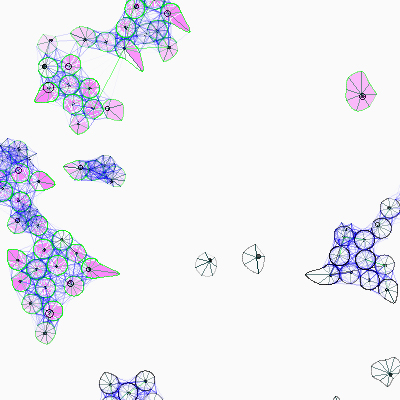

Okay, let's talk a bit about my studio work.
Above is a pic of some cells living off each other's energy. As I mentioned before, I got the code for this from a guy named Michael "Flux" Chang who is a student at UCLA, and a very helpful fellow. I have since migrated the original proce55ing code into java and am writing pure java from here on out.
proce55ing, incidentally, is a free scripting language for simple graphics written in a subset of java by a couple of guys who started the work at MIT, I think. Check out
www.proce55ing.org if you're curious. It's much better than Flash for any images that are algorithmically driven... i.e. anything that requires a lot of computation to decide what to draw.
My little cellular system is a work in progress... basically these individuals form networks (as seen in the second image, above) of energy exchange, which keeps them alive. I've added a whole class of information objects that the individuals exchange each time they meet. What I'm trying to model is this incidental exchange of information that piggy-backs on an essential connection. I have more work to do on this... my goal is to have the information that the cells exchange actually be about how they interconnect, so that as they trade ideas
it changes the way they organize themselves. Or something like that.
I have a background in software development, mostly programming in C++, so I have been enjoying, to some extent, the chance to get back
into coding. The quantity of control I have over what's going on on the screen is so satisfying (compared to working in an animation tool
where I am always choosing from options I don't like). But I'm not quite sure where this work is leading. I'm going to take a step back over the next couple of days, try to read these ideas into film, and
try to develop a larger narrative for my project.
Thankfully Ed K. encourages us to work in parallel, between reading and film analysis, 'diagramming', and developing our own focused ideas of how we want to intervene in the larger "site" of the studio (see my entry called "Week 4, right?" for a little more info on the studio). He also has what I would call a very mature approach to the diagram. He is encouraging us -- through various means, be they coding cellular automata, creating dynamic models in Maya, or physical models (one guy is doing pours of hot wax and cold water, etc.) -- to create complex
scenarios from which we can extract organizational patterns. Rather than "building the diagram", however, we will then try to find analogies or parallels in human structures (physical, social) at all sorts of scales. So some things might make sense at the scale of a family, some at the scale of the city.
Actually before we take these patterns to the real world, we're reading them into films, which I'm starting to realize is a pretty good technique. Film provides a designed, structured view of reality that can be a useful bridge between the abstraction of diagrams and the messiness of everyday life. But I haven't really tried to analyze any films as yet, so I am jumping the gun...
Oh, and I've discoverd that Ed has a design firm, in partnership with his wife Carla Leitao, that does architecture (well, they are finally building something, I think). They have a nice website, that I can't
for the life of my find on Google. I will include a link shortly (I'll have to ask around).






4 Comments
george -
it would be great to see a list of the films your studio is using to get at the organizational ideas. cheers.
Aha, sure thing:
The film list, from the studio spec (see the full thing by digging through the GSAPP obfuscator--I mean, webpage--and finding Ed Keller's studio):
REQUIRED SCREENINGS
Koyanisquatsi: Reggio
Lessons of Darkness: Herzog
Once Upon a Time in the West: Leone
Mamma Roma: Pasolini
Chinatown: Polanski
Easy Rider: Hopper
Beau Travail: Denis
Playtime: Tati
Crash: Cronenberg
Lost Highway: Lynch
Paris, Texas: Wenders
Man With a Movie Camera: Vertov
Passenger, Zabriskie, Point, Red Desert: Antonioni
Repo Man: Cox
Until the End of the World: Wenders
Fear and Loathing in Las Vegas: Gilliam
Polygraph: LePage
Only some of these are really about organization thinking... a large number of them have to do with the psychology of the desert, or with manifestations of energy. But, as a simple example, in Mulholland Drive you could say that people create relationships trying to get ahead in the film industry, only to find that the secondary effect of destructive love hops along those relationships and has unintended consequences.
Have you watched Koyaanisqatsi yet? I'd be interested to hear what you think of it...
Yes, watched Koyaanisqatsi! It's a mixed bag, I think, but overall very worthwhile. The music and the sentiment behind the movie are both a little cheesy (i.e. sentimental), I think, but the individual scenes are stunning. It's amazing how much we can surprise ourselves just be slowing things down or speeding them up. Well, I wish they had done more slowing down, actually... they never really went slower than "real time". Still, the jumps in scale in space and in time add up to a great mental exercise for architectural and urbanistic thinking. And I'm not that against the music, I just think it is rather heavy-handed in places.
Werner Herzog's "Lessons of Darkness" is along the same lines, with incredible, operatic (there is literally Mahler playing in the background, or something like him) helicopter trips through the smoke from the post-Kuwait oil fires. I highly recommend it; the huge flames and smoke are hypnotic both for their shifting light and the shifting metaphors they evoke. Plus the wrecked oil drums in the desert are shocking. Right, great film, enough babbling.
Block this user
Are you sure you want to block this user and hide all related comments throughout the site?
Archinect
This is your first comment on Archinect. Your comment will be visible once approved.